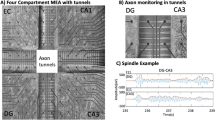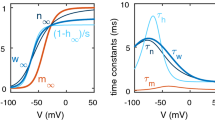Summary
The muscle contraction rhythm and the impulse patterns of motor neurons producing that rhythm in the swimming leech were studied over a wide range of swim cycle periods. This cycle consists of a constant time sector lasting about 300 msec and a variable time sector whose changes in length are responsible for the variation in cycle period from about 400 to 2000 msec. The constant time sector consists of the contraction and relaxation of the dorsal and the ventral segmental longitudinal muscles. The variable time sector consists of preparing for the next contractile event. The constancy of the contractile component of the swimming cycle is accounted for by the relative period-independence of the impulse frequency during the bursts of the excitors which command the rhythmic contraction of the dorsal and the ventral longitudinal muscles. Since the impulse frequency of a longitudinal muscle inhibitor does increase as the period shortens and since the burst of this inhibitor occurs during the variable time sector of the cycle, the activity of the inhibitor seems to determine the timing of the next contractile event.
The impulse bursts of bilaterally homologous motor neurons are closely coordinated with respect to burst duration, spike number per burst and burst phase, in agreement with the earlier finding that the homologs are linked by electrotonic junctions. The delay between the bursts of the dorsal excitors and the ventral excitors increases with increasing period in a manner which indicates that about three fourths of the variable time sector and no more than one fourth of the constant time sector occur between the command of dorsal and of ventral longitudinal muscle contraction.
The rearward propagation of the swimming wave along the leech body is reflected in an antero-posterior sequence of bursts of the intersegmental homologs of a dorsal excitor. Periodic spike bursts matching the swimming rhythm can be recorded from the connective linking the ganglia of the cord. It is likely that these spike bursts represent the impulse traffic of axons responsible for the intersegmental coordination of the swimming rhythm. These studies show that the swimming rhythm of leeches and its neuronal control formally resemble three well-studied cases of rhythmic movements of arthropods, namely insect ventilation, decapod swimmeret beating and insect walking.
Similar content being viewed by others
References
Davis, W. J.: Quantitative analysis of swimmeret beating in the lobster. J. exp. Biol.48, 643–662 (1968)
Davis, W. J.: The neural control of swimmeret beating in the lobster. J. exp. Biol.50, 99–117 (1969)
Delcomyn, F.: The locomotion of the cockroach,Periplaneta americana. J. exp. Biol.50, 99–117 (1969)
Evoy, W. H., Kennedy, D., Wilson, D. M.: Discharge patterns of neurons supplying tonic abdominal flexor muscles in the crayfish. J. exp. Biol.46, 393–411 (1967)
Graham, D.: A behavioural analysis of the temporal organization of walking movements in the first instar and adult stick insect (Carausius morosus). J. comp. Physiol.81, 23–52 (1972)
Gray, J., Lissmann, H. W., Pumphrey, R. J.: The mechanism of locomotion in the leech (Hirudo medicinalis Ray). J. exp. Biol.15, 408–430 (1938)
Hughes, G. M., Wiersma, C. A. G.: The coordination of swimmeret movements in the crayfishProcambarus clarkii (Girard). J. exp. Biol.37, 657–670 (1960)
Kristan, W. B., Jr.: Characterization of connectivity among invertebrate motor neurons by cross-correlation of spike trains. Neurosciences: Third Study Program, p. 371–378, Schmitt, F. O., Worden, F., eds. Cambridge: Massachusetts Institute of Technology Press 1973
Kristan, W. B., Jr., Stent, G. S., Ort, C. A.: Neuronal control of swimming in the medicinal leech. I. Dynamics of the swimming rhythm. J. comp. Physiol.94, 97–119 (1974)
Ort, C. A., Kristan, W. B., Jr., Stent, G. S.: Neuronal control of swimming in the medicinal leech. II. Identification and connections of motor neurons. J. comp. Physiol.94, 121–154 (1974)
Pearson, K. G.: Central programming and reflex control of walking in the cockroach. J. exp. Biol.56, 173–193 (1972)
Pearson, K. G., Iles, J. F.: Discharge patterns of coxal levator and depressor motorneurons of the cockroach,Periplaneta americana. J. exp. Biol.52, 139–165 (1970)
Pearson, K. G., Iles, J. F.: Nervous mechanisms underlying intersegmental coordination of leg movements during walking in the cockroach. J. exp. Biol.58, 725–744 (1973)
Pickard, R. S., Mill, P. J.: Ventilatory muscle activity in intact preparations of aeshnid dragonfly larvae. J. exp. Biol.56, 527–536 (1972)
Stein, P. S. G.: Intersegmental coordination of swimmeret motorneuron activity in the crayfish. J. Neurophysiol.34, 310–318 (1971)
Stuart, A. E.: Physiological and morphological properties of motorneurons in the central nervous system of the leech. J. Physiol. (Lond.)209, 627–646 (1970)
Wendler, G.: The co-ordination of walking movements in arthropods. In: Nervous and hormonal mechanisms of integration. Symp. Soc. exp. Biol.20, 229–249 (1966)
Wiersma, C. A. G., Ikeda, K.: Interneurons commanding swimmeret movements in the crayfish,Procambarus clarkii (Girard). Comp. biochem. Physiol.12, 509–525 (1964)
Wilson, D. M.: Insect walking. Ann. Rev. Entomol.11, 103–122 (1966)
Author information
Authors and Affiliations
Additional information
We thank Elizabeth Mullenbach for excellent technical assistance, and Ellis N. Story, Jr. for graphic and photographic work. This research was supported by Grant No. GB31933 X from the National Science Foundation, and Public Health Service Grant No. GM1786 and Training Grant No. GM01389 from the Institute for General Medical Sciences. One of us (W. B. K.) began these studies as a Public Health Service Postdoctoral Fellow in the laboratory of Professor Donald Kennedy at Stanford University.
Rights and permissions
About this article
Cite this article
Kristan, W.B., Stent, G.S. & Ort, C.A. Neuronal control of swimming in the medicinal leech. J. Comp. Physiol. 94, 155–176 (1974). https://doi.org/10.1007/BF00617839
Received:
Issue Date:
DOI: https://doi.org/10.1007/BF00617839




